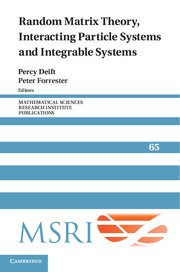Book contents
- Frontmatter
- Contents
- Preface
- Universality conjecture for all Airy, sine and Bessel kernels in the complex plane
- On a relationship between high rank cases and rank one cases of Hermitian random matrix models with external
- Riemann–Hilbert approach to the six-vertex model
- CLT for spectra of submatrices of Wigner random matrices, II: Stochastic evolution
- Critical asymptotic behavior for the Korteweg–de Vries equation and in random matrix theory
- On the asymptotics of a Toeplitz determinant with singularities
- Asymptotic analysis of the two-matrix model with a quartic potential
- Conservation laws of random matrix theory
- Asymptotics of spacing distributions 50 years later
- Applications of random matrix theory for sensor array imaging with measurement noise
- Convolution symmetries of integrable hierarchies, matrix models and τ-functions
- Universality limits via “old style” analysis
- Fluctuations and large deviations of some perturbed random matrices
- Three lectures on free probability
- Whittaker functions and relatedstochastic processes
- How long does it take to compute the eigenvalues of a random symmetric matrix?
- Exact solutions of the Kardar–Parisi–Zhang equation and weak universality for directed random polymers
- Replica analysis of the one-dimensional KPZ equation
- Asymptotic expansions for β matrix models and their applications to the universality conjecture
- KPZ scaling theory and the semidiscrete directed polymer model
- Experimental Realization Of Tracy–Widom Distributions And Beyond: Kpz Interfaces In Turbulent Liquid Crystal
- Random matrices: the four-moment theorem for Wigner ensembles
Conservation laws of random matrix theory
Published online by Cambridge University Press: 29 May 2025
- Frontmatter
- Contents
- Preface
- Universality conjecture for all Airy, sine and Bessel kernels in the complex plane
- On a relationship between high rank cases and rank one cases of Hermitian random matrix models with external
- Riemann–Hilbert approach to the six-vertex model
- CLT for spectra of submatrices of Wigner random matrices, II: Stochastic evolution
- Critical asymptotic behavior for the Korteweg–de Vries equation and in random matrix theory
- On the asymptotics of a Toeplitz determinant with singularities
- Asymptotic analysis of the two-matrix model with a quartic potential
- Conservation laws of random matrix theory
- Asymptotics of spacing distributions 50 years later
- Applications of random matrix theory for sensor array imaging with measurement noise
- Convolution symmetries of integrable hierarchies, matrix models and τ-functions
- Universality limits via “old style” analysis
- Fluctuations and large deviations of some perturbed random matrices
- Three lectures on free probability
- Whittaker functions and relatedstochastic processes
- How long does it take to compute the eigenvalues of a random symmetric matrix?
- Exact solutions of the Kardar–Parisi–Zhang equation and weak universality for directed random polymers
- Replica analysis of the one-dimensional KPZ equation
- Asymptotic expansions for β matrix models and their applications to the universality conjecture
- KPZ scaling theory and the semidiscrete directed polymer model
- Experimental Realization Of Tracy–Widom Distributions And Beyond: Kpz Interfaces In Turbulent Liquid Crystal
- Random matrices: the four-moment theorem for Wigner ensembles
Summary
This paper presents an overview of the derivation and significance of recently derived conservation laws for the matrix moments of Hermitian random matrices with dominant exponential weights that may be either even or odd. This is based on a detailed asymptotic analysis of the partition function for these unitary ensembles and their scaling limits. As a particular application we derive closed form expressions for the coefficients of the genus expansion for the associated free energy in a particular class of dominant even weights. These coefficients are generating functions for enumerating g-maps, related to graphical combinatorics on Riemann surfaces. This generalizes and resolves a 30+ year old conjecture in the physics literature related to quantum gravity.
1. Introduction
We present an overview of some recent developments in the application of random matrix analysis to the topological combinatorics of surfaces. Such applications have a long history about which we should say a few words at the outset. The combinatorial objects of interest here are maps. A map is an embedding of a graph into a compact, oriented and connected surface X with the requirement that the complement of the graph in X should be a disjoint union of simply connected open sets. If the genus of X is g, this object is referred to as a g-map. The notion of g-maps was introduced by Tutte [1968] and his collaborators in the 1960s as part of their investigations of the four color conjecture.
In the early 1980s Bessis, Itzykson and Zuber, a group of physicists studying 't Hooft's diagrammatic approaches to large-N expansions in quantum field theory, discovered a profound connection between the problem of enumerating g-maps and random matrix theory [Bessis et al. 1980]. That seminal work was the basis for bringing asymptotic analytical methods into the study of maps and other related combinatorial problems. Subsequently other physicists [Douglas and Shenker 1990; Gross and Migdal 1990] realized that the matrix model diagrammatics described by Bessis et al. provide a natural means for discretizing the Einstein–Hilbert action in two dimensions.
Information
- Type
- Chapter
- Information
- Publisher: Cambridge University PressPrint publication year: 2014
